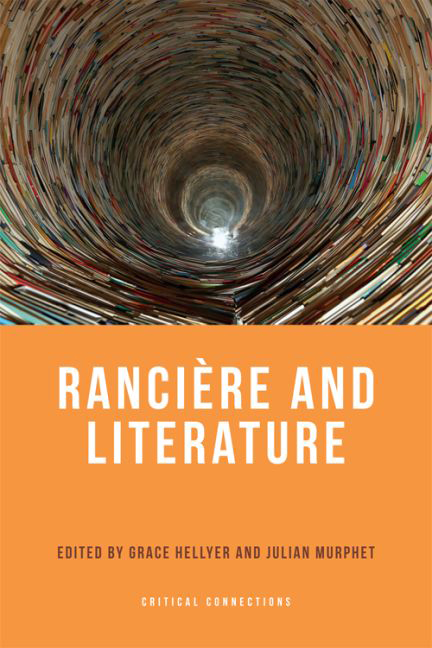Book contents
- Frontmatter
- Contents
- Acknowledgements
- Notes on Contributors
- Introduction: Rancière and Literature
- SECTION I Coordinates
- 1 Fictions of Time
- 2 Jacques Rancière in the Forest of Signs: Indiscipline, Figurality and Translation
- 3 Rancière and Tragedy
- 4 Rancière Lost: On John Milton and Aesthetics
- 5 ‘A New Mode of the Existence of Truth’: Rancière and the Beginnings of Modernity 1780–1830
- SECTION II Realisms
- SECTION III Contemporaneities
- Index
3 - Rancière and Tragedy
from SECTION I - Coordinates
Published online by Cambridge University Press: 15 September 2017
- Frontmatter
- Contents
- Acknowledgements
- Notes on Contributors
- Introduction: Rancière and Literature
- SECTION I Coordinates
- 1 Fictions of Time
- 2 Jacques Rancière in the Forest of Signs: Indiscipline, Figurality and Translation
- 3 Rancière and Tragedy
- 4 Rancière Lost: On John Milton and Aesthetics
- 5 ‘A New Mode of the Existence of Truth’: Rancière and the Beginnings of Modernity 1780–1830
- SECTION II Realisms
- SECTION III Contemporaneities
- Index
Summary
Tragedy as missing object: genre, spectacle or history
For some philosophers tragedy furnishes a key to modernity: the death of tragedy forms the backdrop against which modernity is defined; or tragedy plays the role of first critique of modernity; or modernity is characterised by the impossibility of writing tragedy. Such speculations seem quite foreign to Rancière's approach to literary modernity, in which the novel takes pride of place, blurring the lines between art and life, scavenging amongst commerce and law for its words and objects, foregrounding the mundane micro-events of everyday life, slowly undoing social hierarchies, rendering obsolete any distinction between sacred and profane, noble and vulgar, high and low. His champions are not Hölderlin and Hegel but Balzac and Flaubert. ‘What careful pacing of episodes in a drama,’ he asks, rhetorically, ‘what tragic hero's internal strife will ever equal the power of language present in the shambles of the Galeries de Bois, but also, and every bit as much, in cousin Pons’ hat and spencer?’ His heroic anti-heroic crusade continues: ‘the democracy of mute things […] talk[s] better than any prince of tragedy.’ Elsewhere he simply notes ‘We no longer do tragedies’ with regard to the dissolution of the system of genres favoured in the eighteenth century. Not only that but Rancière also criticises the pertinence of the term ‘modernity’, preferring to replace it with a set of competing regimes for the identification of art: the ethical, the representational and the aesthetic, with the aesthetic gaining the upper hand from the mid eighteenth century onwards.
When Rancière does mention tragedy it is to refer to another thinker's conception of it. For instance in the early essay ‘The People's Theatre’, he dismisses Michelet's use of the term to designate an ideal communion of the people with itself through theatrical representation. This is an ideal, Rancière claims, that the subsequent history of popular theatre reveals to be unreachable and misguided.
- Type
- Chapter
- Information
- Rancière and Literature , pp. 58 - 75Publisher: Edinburgh University PressPrint publication year: 2016



